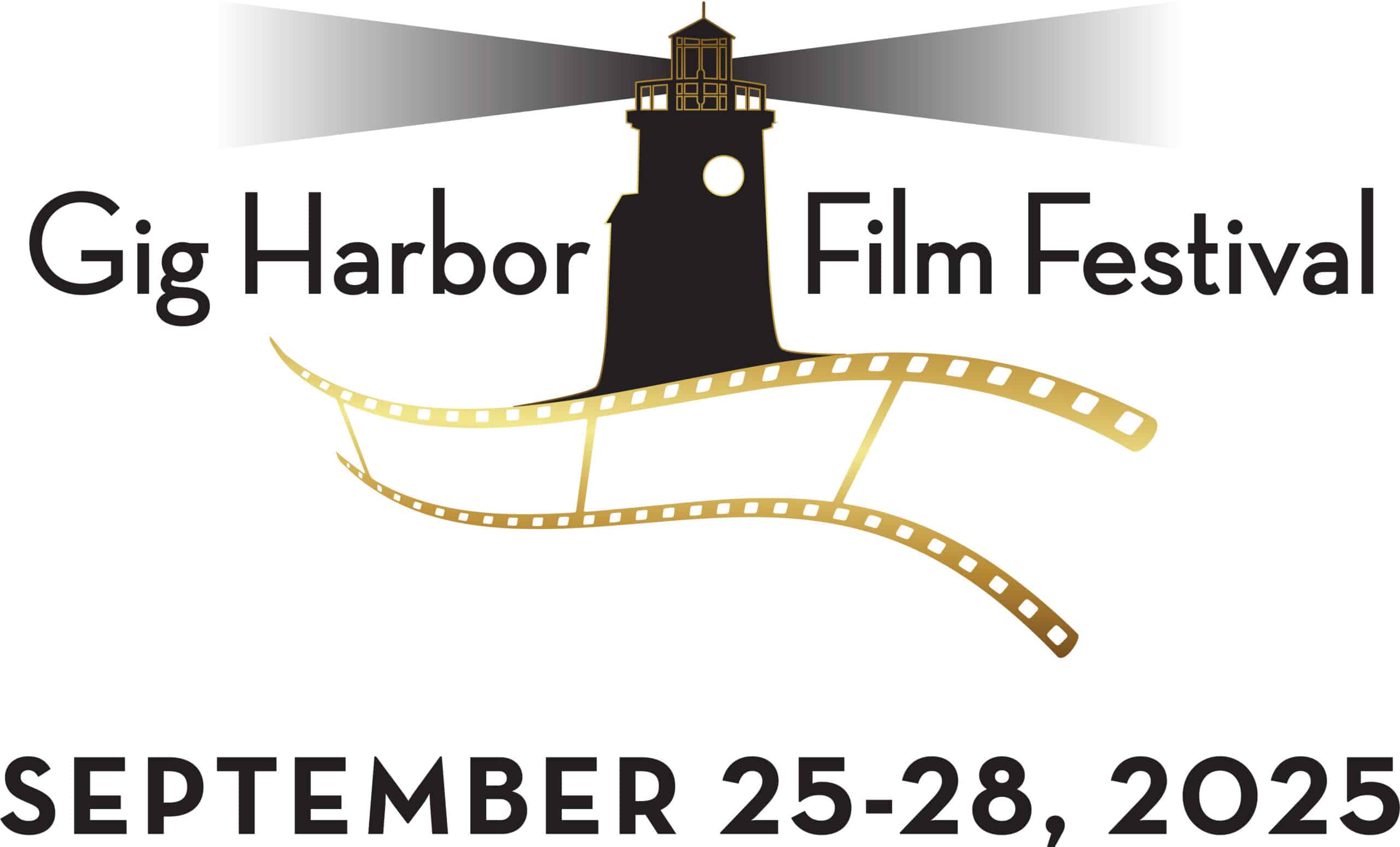Arts & Entertainment Community
Day Tripper | Tacoma’s Museum District
Many of us think of Tacoma as the town where Highway 16 merges with Interstate 5, allowing us to travel north to Seattle or south to Olympia and beyond.
Arts & Entertainment Sponsor
Arts & Entertainment stories are made possible in part by the Gig Harbor Film Festival, a proud sponsor of Gig Harbor Now.
And many of us of a certain age still harbor memories of the days when you knew you were in Tacoma because of the infamous “aroma of Tacoma.” I remember a trip home from Seattle with three kids in the backseat. About the time we hit Fife, the car grew silent. A look in the rearview mirror confirmed that three small people were holding their noses as best they could while we passed through miles of the smells of rotting sawdust from the Tideflats, sulfur from the smelter, and the fragrant odor of brine from the Nalley Valley.
Those days are pretty much gone thanks to environmental remediation efforts.
It’s not your grandfather’s Tacoma anymore. A friend and I decided to check out the area of downtown Tacoma known as the Museum District. We really should call it Chihuly-ville. If you haven’t visited downtown Tacoma recently, it’s time to check it out again. The half-mile square area surrounding the former Union Station has become a vibrant cultural center well worth exploring.
The hub of the Museum District is the former Union Station, which is now the federal courthouse. Just two-tenths of a mile north is TAM, the Tacoma Art Museum. The Museum of Glass is about a quarter-mile away, directly south of the Washington State History Museum (you can get to the glass museum by crossing the elevated Glass Bridge that spans I-705). Directly across Pacific Avenue from the courthouse sits the University of Washington-Tacoma campus. One parking place, six fascinating places to see.
The Union Station/courthouse conversion
In 1873, the Northern Pacific Company named Tacoma as the western terminus of the northern route of the transcontinental railroad. The city became a center for industrial and commercial development and was coined the “City of Destiny.”
The city’s first train station was built in 1883 and moved to its current site in 1892. Construction of Union Station finished in May 1911.
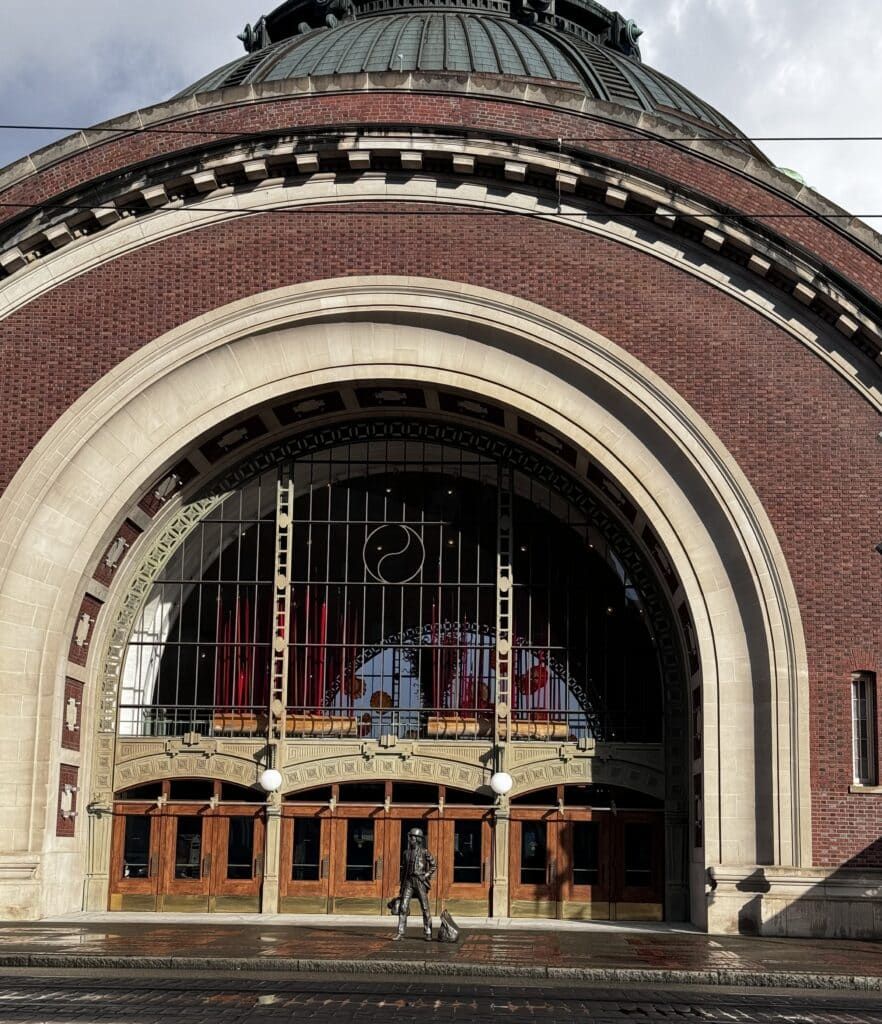
The federal courthouse in Tacoma, formerly Union Station. Photo by Mary Williams
Railway ridership peaked in the 1930s and again during World War II, then quickly declined as the automobile became the preferred form of transportation. In 1971, when the national passenger rail service became Amtrak, the Tacoma offices relocated to Seattle. The last passenger train left Union Station on June 14, 1984; the building was soon abandoned and fell into disrepair.
In 1987, Congress authorized the GSA to lease the station to acquire space for the federal courts. With a 35-year lease in hand, over the next three years, the building was completely renovated and restored, and a three-story addition was constructed. The centerpiece of the building is its 90-foot-high central dome. It is clad in copper and adorned with four large cartouches. The dome sits on a central pavilion with large arched openings on each side.
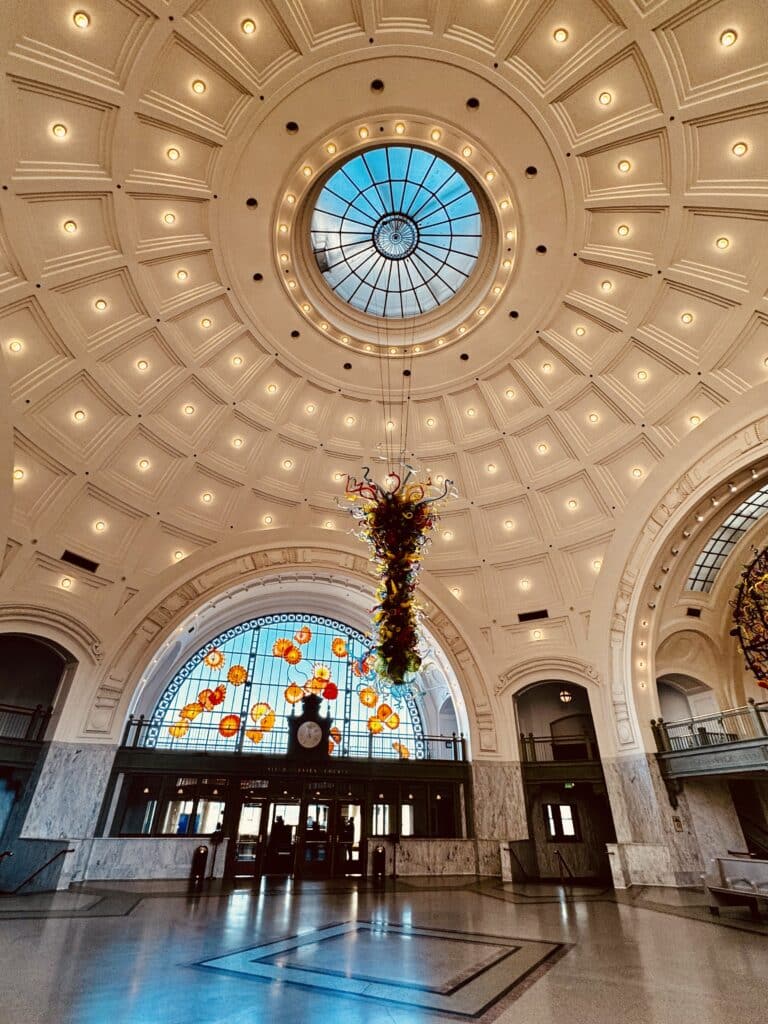
The dome in the Tacoma federal courthouse. Photo by Mary Williams
Inside the courthouse
Natural light streams into the rotunda, which houses a collection of glass art by (who else?) Dale Chihuly. Suspended from the center of the ceiling is one of his most stunning pieces, a 20-foot chandelier consisting of more than 2,799 multi-colored globes.
The rotunda also retains several historically significant features including a large clock, marble fountains and wooden benches.
Union Station was listed in the National Register of Historic Places in 1974. In 1980, a seven-block area surrounding the station was also designated a historic district and listed in the National Register of Historic Places.
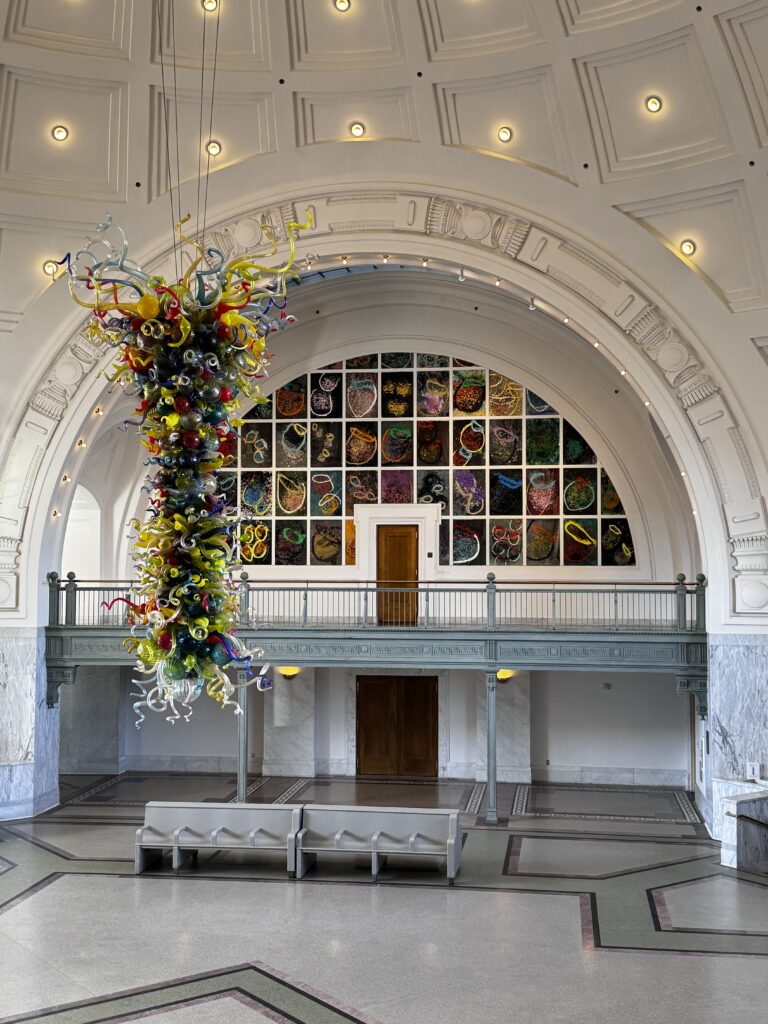
Inside the federal courthouse in Tacoma. Photo by Mary Williams
Located at 1717 Pacific Ave., the courthouse is open weekdays from 7 a.m. to 5 p.m., closed on federal holidays. Government-issued photo ID is required for entry. No food or liquids are allowed through security. Enter on Pacific Avenue or from the entrance adjacent to the Liberty Bell on the bottom level.
The Liberty Bell Replica
Soon after the end of World War II, as part of the Marshall Plan, the U.S. Department of the Treasury held a “Save For Your Independence” savings bond drive. To support the drive, President Harry S. Truman had 55 full-size replicas of the Liberty Bell cast and gifted one to each state and territory.
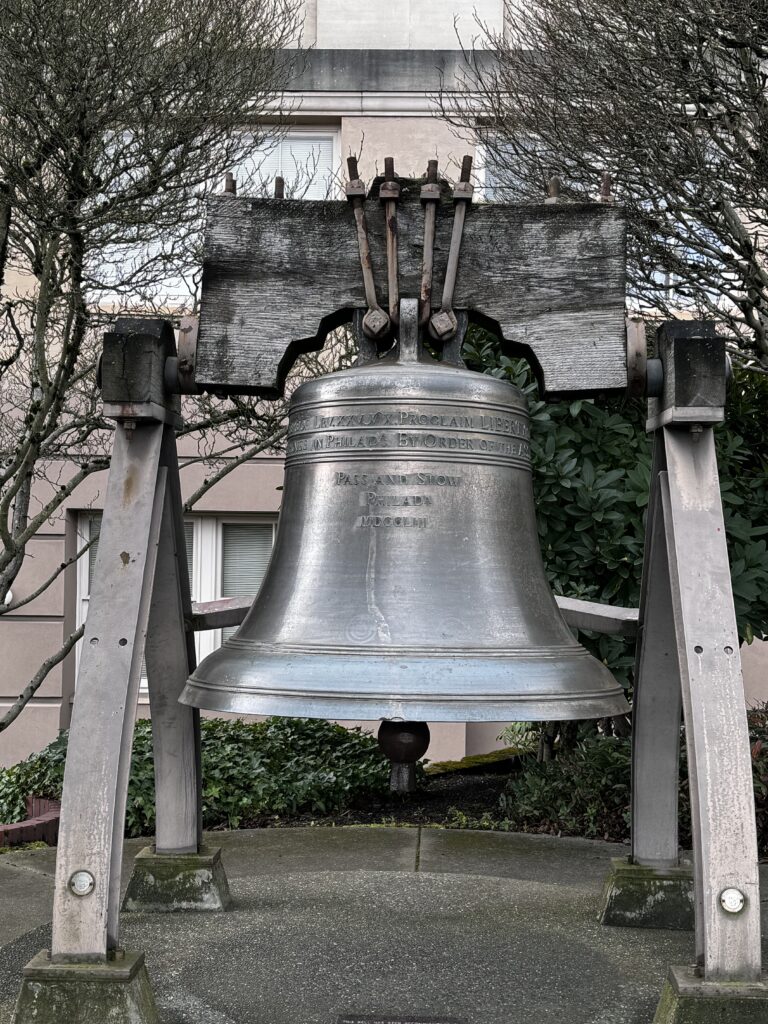
This Liberty Bell replica near the federal courthouse in Tacoma. Photo by Mary Williams
The original agreement with the states required the bells to be somewhere on state capitol grounds. Today, a handful of states have them elsewhere.
Instead of the capitol campus in Olympia, the Washington state bell resides in a grotto just behind the courthouse in downtown Tacoma. I did quite a bit of research into how and when this happened — but I wasn’t successful in learning that, so I cut my losses.
One theory seems to be that when the federal government took over Union Station and decided to convert it to the federal courthouse, they decided it would also be OK to add this symbol of our nation’s history to the ambience and landscaping. I’m willing to accept that and move on.
In my travels, I’ve visited about 35 of the other bells. Few of them still have their clappers. Of the ones that do, most have signs that basically say “Hands Off.”
My friend had never seen one of the bells before. Noting that ours has its clapper, she wondered if it would ring, grabbed the clapper, and let it fly. Be assured that it does, and that if there were any spirits in neighboring buildings, they have been awakened.
The Washington State History Museum
The Washington State History Museum is home to a series of exhibits that trace the development of the state as we know it. There are way too many exhibits to detail them all here, but I can guarantee that just about everyone can find something that will interest them. The easiest way to plan your visit is to check out the museum’s website.
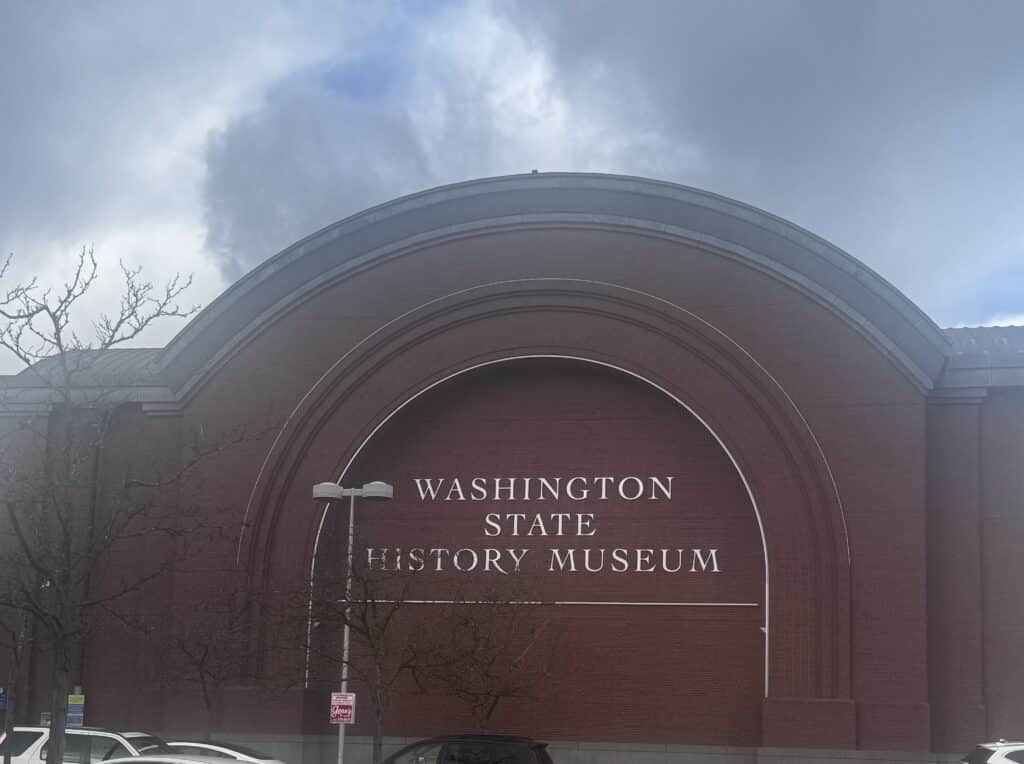
The Washington State History Museum in Tacoma. Photo by Mary Williams
There is some urgency if you think you’d like to see Avis Marvelous. Curated by Lee Silliman, it features over 50 historic engravings that provide a sampling of the documentation and art produced about birds in the North American West during this era. It has been here since Oct. 7, but its last day is Sunday, March 3.
It will be replaced by Journeys: Quilts from the Contemporary QuiltArt Association & Pacific Northwest African American Quilters. Journeys runs from March 16 through June 23 of this year.
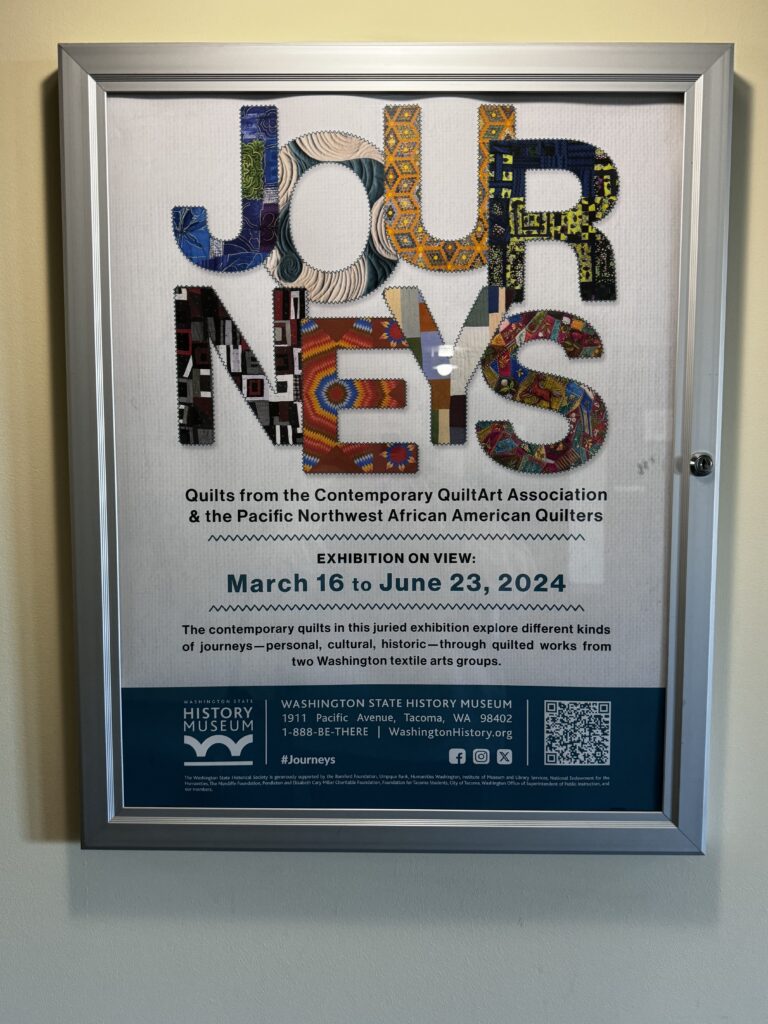
Coming soon to the Washington State History Museum. Photo by Mary Williams
My colleagues at Gig Harbor Now and I may be particularly interested in a permanent exhibition, News of the Day. It looks at how news has been communicated over time and has impacted how we understand current and historical events and relate them to our lives.
Among the many items featured are clips of newsreel footage from the collapse of Galloping Gertie and an intertype machine used by the Seattle Times during the 1960s and ’70s.
Railroads
The museum is home to the largest model railroad on permanent exhibition in Washington state. Built, operated, and maintained by the nonprofit Puget Sound Model Railroad Engineers, it is located on the fifth floor of the museum.
The theme of the exhibit is Washington in the 1950s. Tracks and equipment are reminiscent of the Great Northern, Northern Pacific, Union Pacific and Milwaukee Road railroads. The first Saturday of every month, engineers run the trains from noon to 4 p.m., following real railroad procedures.
Each December, the museum hosts an annual Model Train Festival. Model railroad clubs from around the region set up room-sized layouts throughout the museum. The festival runs from late December through early January and admission is included with a history museum membership.
Located at 1911 Pacific Ave., the history museum is open from 10 a.m. to 5 p.m. Tuesday through Sunday. On the third Thursday of the month, the museum remains open until 8 p.m., with free admission between 3 p.m. and 8 p.m.
Admission is $11 for children 6 to 18 and seniors (65+), and $14 for adults. Memberships, which provide free access to the museum, are available starting at $50 for an individual or two adult seniors, $75 for a household, and up.
The Bridge of Glass
On the Pacific Avenue level, walk between the History Museum and the courthouse and you will find the path leading to the Bridge of Glass. The bridge is one of the most awesome things to visit in the area.
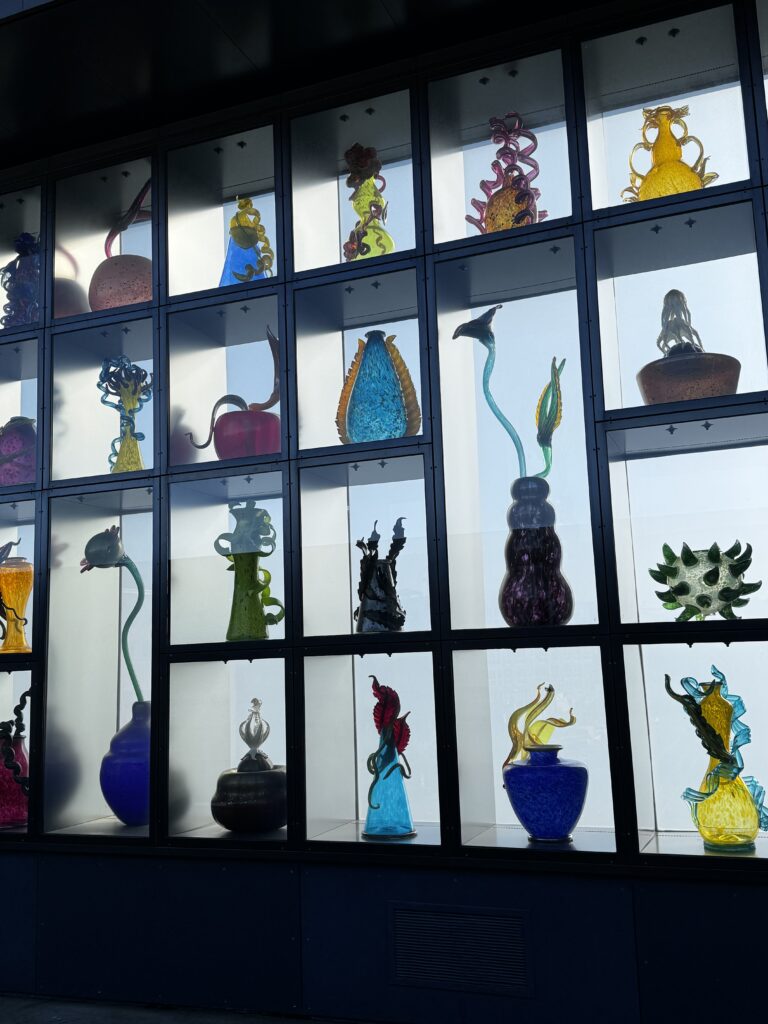
The Bridge of Glass in Tacoma’s Museum District. Photo by Mary Williams
The glass-filled ceiling contains 2,364 bits and pieces of glass. The Venetian Wall features 109 glass vases. No two are alike. Some feature twisting spirals, glass sea creatures, cherubs, and flowers. They make up the largest collection of small glass art in one spot that can be accessed for free. On a sunny day, driving down the Thea Foss Waterway provides an amazing, if fleeting, view of the art.
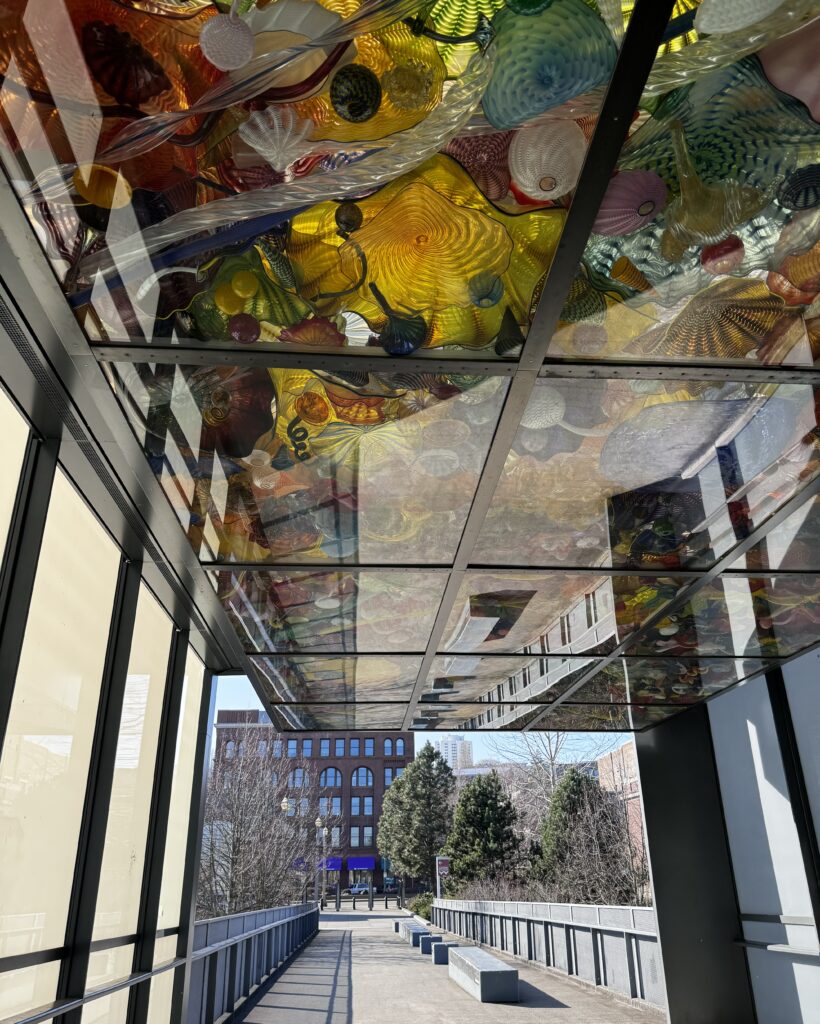
The Bridge of Glass in Tacoma’s Museum District. Photo by Mary Williams
At night, the entire structure is lighted. Most days, particularly clear ones, it provides a view of the mountain, most of Tacoma, the Dome, LeMay, and the waterway. You can, of course, also see the Museum of Glass.
The Museum of Glass
A perfect convergence of need and opportunity brought the Museum of Glass to the Thea Foss Waterway in Tacoma. In 1992, Dr. Philip Phibbs, the recently retired president of the University of Puget Sound; Dale Chihuly, leader of the Studio Glass movement and pre-eminent glass artist in the U.S.; and George Russell, chairman of the Executive Council for a Greater Tacoma, came together to develop the concept of the Museum of Glass as the anchor tenant on a restored Thea Foss Waterway. At that time, the narrow waterway qualified as a federal Superfund clean-up site.
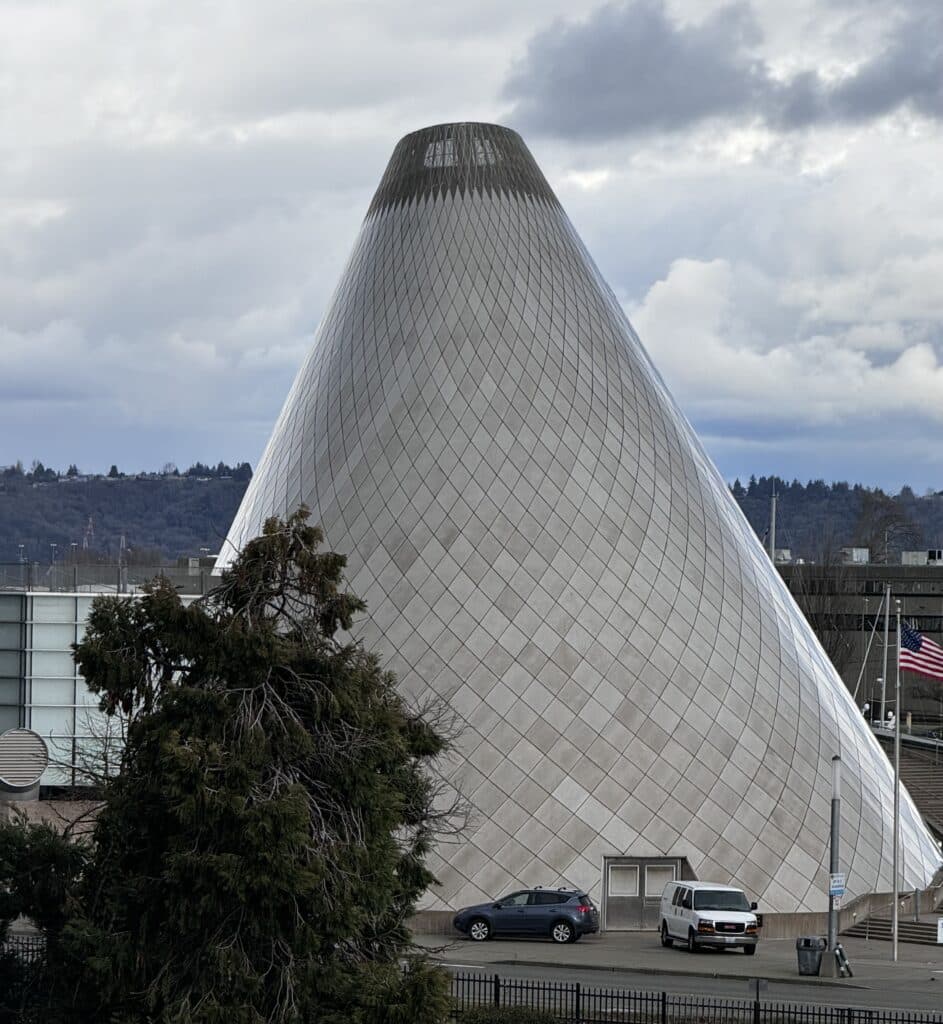
The Museum of Glass in Tacoma. Photo by Mary Williams
The original plan included the concept of a large glass studio where visitors could watch artists create art from molten glass. The Hot Shop Amphitheater inside the 90-foot tall steel cone achieves that goal.
The museum was envisioned as a center that nurtures artists, celebrates the Studio Glass movement and encourages creativity. It is all that, and more.
The museum opened to the public in 2002. It is a four-story structure with several levels of outdoor plazas, a reflecting pool, and seating areas. The Museum Café features Argentinian street food, as well as sandwiches, soups and snacks. The Museum Store provides an opportunity to pick up a small trinket or a piece of fine art.
Located at 1801 Dock St., the museum is open from 10 a.m. to 5 p.m. Wednesday through Sunday. It is open until 8 p.m. on the third Thursday of each month. Admission is free from 5 to 8 p.m. Thursdays. Admission is $12 for children 6 to 18, $18 for seniors, college students, and military, and $20 for adults. College students are free on Sundays with valid student ID.
Memberships are available. For additional options, check out their website.
The Tacoma Art Museum
Our southern terminus houses the Tacoma Art Museum, which is home to more than 5,000 works of art, primarily focusing on western region artists. Of course, it has a large collection of Chihuly glass pieces. Also included are 14 landscapes and another 300 pieces from the Haub Family Collection of western American art. Included with the landscapes are land acknowledgements to the 75 tribes represented. The works cover more than 200 years of western American history.
Other collections found at the museum include 19th century European art and a large holding of Japanese woodblock prints. It is also home to the Benaroya Collection of 225 works including studio art glass, paintings, and sculptures.
The Tacoma Art Association, a group of volunteers, founded the museum in 1935. Over time, it has outgrown five exhibition spaces, and has been at its current location since 2003. At that time, the cost of construction was $22 million.
The Haub Family Galleries were added in 2014 to house works dating as far back as 1790, adding 16,000 square feet of exhibit space. Another wing gifted in 2016 houses the Benaroya collection. Completed in January 2019, it added another 7,390 square foot gallery. It is also home to a cool Museum Shop and Café.
Located at 1701 Pacific Ave., TAM is open from 10 a.m. to 5 p.m. Wednesday through Sunday. On Thursday, the museum remains open until 8 p.m., with free admission between 5 p.m. and 8 p.m. Admission is $10 for children 6 to 18, $15 for seniors (65+), and $15 for adults. Memberships are available starting at $50 for an individual, $85 for a household, and up. Membership provides free access to the museum.
University of Washington Tacoma
When the permanent campus of the University of Washington-Tacoma opened in September 1997, it signified the final step in the rebirth of the area. The campus emerged from a low-end warehouse district full of abandoned WWII-era Jeeps, pigeons, and decrepit buildings.
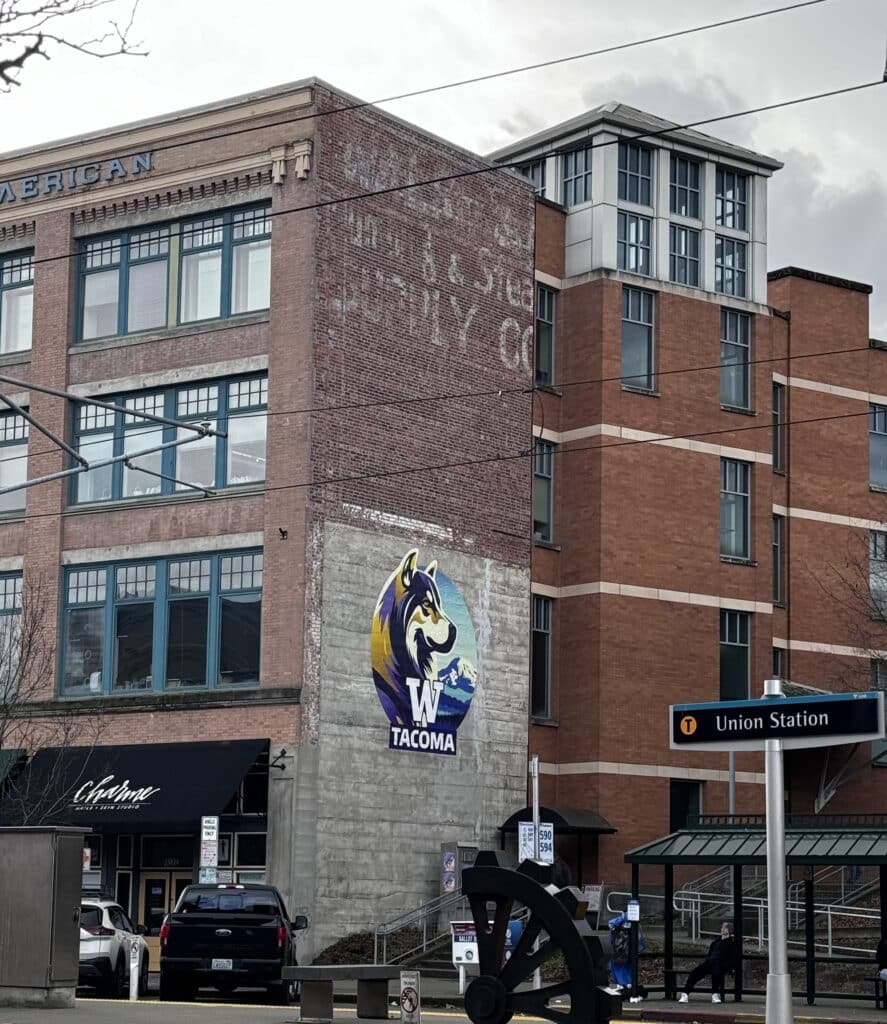
The Tacoma campus of the University of Washington. Photo by Mary Williams
Six historic brick structures were gutted, upgraded and wired for 21st century technology. The library’s reading room once served as a power station. Dank warehouse rooms are now open offices, meeting spaces and classrooms, most with plenty of natural light. New elevators and ramps ensure that the 100-year-old buildings provide modern forms of access and meet ADA standards.
Technically, we’re not through with what is actually considered to be the Museum District. It also includes the Lemay Car Museum, the Children’s Museum, and the Foss Waterway Seaport Maritime Museum. And that’s just the museums.
I never realized how much there is to see and do just across the bridge in Tacoma. Tacoma used to be a place you went through on your way to someplace else, but not anymore. Now it’s a destination. As the Terminator would say, “I’ll be back.”
Getting there
Follow Highway 16 to I-5. Go north on I-5 to the I-705/City Center exit. From I-705, take the 21st Street exit. Veer left at the top of the ramp. Turn right at the light onto Pacific Avenue. The venues are along Pacific Avenue between 19th Street and 16th Street. Parking is available in a lot that is adjacent to the History Museum, and in a lower level lot that runs behind the buildings between the History Museum and Courthouse. Parking is also available on Pacific Avenue and in area pay lots. The Tacoma Museum District is approximately 13 miles from Gig Harbor.
Day Tripper
Gas prices are sky high, and a night in a hotel is approaching astronomically expensive. So, for the foreseeable future, I imagine many of you are going to find yourselves taking day trips rather than the road trip vacations we’ve grown to love.
This beautiful region in which we live is ripe with opportunities to explore new places, see new things, and learn a little something at the same time. I promise to keep the longest journeys to a one-way distance of under 200 miles. Whether you want to make it an overnight trip, a weekend, or just a very long day trip, we should be able to pull it off.
We will also check out some places that tourists flock to see in our beautiful community but most of us either take for granted or have never heard of. If a staycation is on your horizon, I’m here to help you make the most of it.
I hope you’ll grant me the honor of your virtual company as we travel these roads together. Happy trails!

